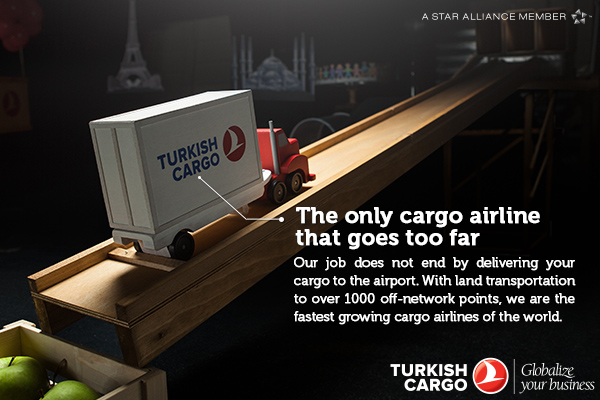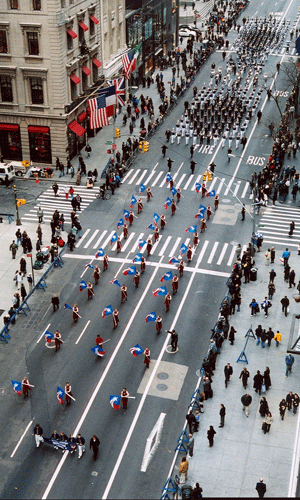
 |
 |
 #INTHEAIREVERYWHERE |
 |
| Vol. 13 No. 92 | Monday
November 10, 2014 |
 |
There is a plan being floated by New York
State to move all air cargo action from JFK International Airport (located
in the Borough of Queens, at a place once called Idlewild), to a sleepy
upstate country location called Stewart International Airport, 60 miles
north of Gotham. A Postscript
|
 |
 What
was a trickle of press releases from forwarders and logistics companies
announcing new cool chain logistics services or the opening of sophisticated
temperature control centers (often located at airports) has turned into
a deluge this year—and with good reason. The strategy behind these
investments is based on the identification of a perfect storm, which is
now propelling demand for the safe transport of temperature sensitive products. What
was a trickle of press releases from forwarders and logistics companies
announcing new cool chain logistics services or the opening of sophisticated
temperature control centers (often located at airports) has turned into
a deluge this year—and with good reason. The strategy behind these
investments is based on the identification of a perfect storm, which is
now propelling demand for the safe transport of temperature sensitive products.New regulations in a number of jurisdictions for products that require consistent sub-zero temperature controls from production through to consumption are one factor. Another regulatory driver is that many products previously shipped at temperatures over 10 degrees Celsius are also now subject to rules on temperature limits throughout the supply chain. Consumers, especially of sensitive food products, also want more certainty that what they buy will not hurt them, or their children. Another driver of demand comes from the growing consumption of biopharmaceutical products, which tend to require temperature-controlled transport due to their biological properties. And the expansion of the middle class in many emerging markets, especially in Asia, is also increasing oversight of supply chains by consumers, and boosting demand for high quality, often foreign, brands. The latter point was highlighted by Japanese transport giant ‘K’ Line when it announced the launch in September of a cold storage joint venture business in Vietnam. The carrier said “the rapid modernization of living styles in Vietnam” was prompting a shift from traditional dietary practices to eating habits that incorporate aspects of foreign cultures. The additional strain that supplying the many small supermarkets and other outlets selling these goods put on existing cool chain networks had highlighted a “shortage of high-performance cold storage” facilities in Vietnam, said the line. All of which is hugely enticing to the air cargo and logistics industries. Perishables often require expedited shipment while pharma cargo tends to be high in value, require enhanced security measures, and are also often needed urgently, which makes them an excellent booster of yields. According to IATA, the global pharmaceutical industry will spend $8.36 billion on cold chain logistics in 2014 and this is expected to expand to more than $10 billion by 2018. But despite the huge recent investment in cold chain and temperature control facilities, in many emerging economies where demand is changing most rapidly, there are still bottlenecks in the cold chain caused by a lack of facilities and/or processing failures. These supply chain breaks are preventing the air freight sector from making the most of cold chain opportunities.  Thomas
Berger, (right) global head of industry vertical healthcare at Panalpina,
said that in Asia most key air freight hubs offer cool chain facilities,
but they usually do not comply with the EU’s Good Distribution Practice
(GDP) guidelines for pharmaceuticals. He also stated that obtaining cargo
clearance was an issue across emerging markets. Thomas
Berger, (right) global head of industry vertical healthcare at Panalpina,
said that in Asia most key air freight hubs offer cool chain facilities,
but they usually do not comply with the EU’s Good Distribution Practice
(GDP) guidelines for pharmaceuticals. He also stated that obtaining cargo
clearance was an issue across emerging markets.“Each location and its processes must be qualified and validated for GDP,” he added. “Setting up GDP compliant operations is key for achieving short transfer times at airports and ports. “We need more tripartite agreements between freight forwarders, carriers and ground handling agents as well as process alignment with authorities and local ministries of health. “More robust and reliable processes at Asia’s airports would certainly improve air freight and make shippers less likely to change to ocean.” Dirk Noelle, Senior Vice-President Airfreight North Asia Pacific, Kuehne & Nagel, said awareness of cold chain logistics as a prerequisite of cargo safety has been growing in importance in Asia. “All major airports have cooling facilities in place and these premises have been designed mostly for perishables business,” he said. However, according to Noelle, perishables facilities are often unsuited to the requirements of the pharmaceutical industry. “Pharma is a growing business in our industry and within China,” he added. “In the long-term, airports and logistics companies will need to adjust their facilities in order to handle pharma products where temperature control is a must.” He also said that customs delays were a major issue. “For example, in China, on average it takes 2-3 days for shipments to be released from customs,” he explained.  Roger
Crook, (left) CEO Board of Management, DHL Global Forwarding, told FlyingTypers
that for many sensitive healthcare, life science, pharmaceutical, and food
products, a seamless supply chain was not only vital, but could also on
occasion be the difference between life and death. Roger
Crook, (left) CEO Board of Management, DHL Global Forwarding, told FlyingTypers
that for many sensitive healthcare, life science, pharmaceutical, and food
products, a seamless supply chain was not only vital, but could also on
occasion be the difference between life and death.“The problem at present is that many in the air cargo industry do not seem sufficiently aware of what the risks are, or what a huge opportunity this is,” he said. “Often cold chain storage and handling facilities at airports are inadequate and unreliable, especially where they are owned and operated by local government authorities. “These failings are compounded by customs regimes which fail to understand that any break in the cold chain carries a risk of product deterioration or fouling, which both drives up costs and increases risk. “This is a growing market and a huge opportunity. If the air freight sector wants to make the most of it, then greater collaboration between stakeholders is required, especially in the emerging markets where we predict that demand will increase a lot in the coming years.” SkyKing |
For someone
who was literally pushed in to the air cargo industry, Padma Handa has
no regrets. In fact, she comes across as one who joined the industry
yesterday. Ever eager to learn how the industry functions, she took
on the mantle of director, Sunrise Freight Forwarders, and decided that
the only way she could progress would be to become proactive. Today,
after more than half-a-dozen years—“I joined in 2006”—she
is not only well aware of the challenges forwarders face in India, but
also knows how best to tackle them. |
 Tell
the industry about a female at any level that you know, or have known about
in air cargo. Write a short essay about what that woman means to air cargo. Pictures
are welcome. Tell
the industry about a female at any level that you know, or have known about
in air cargo. Write a short essay about what that woman means to air cargo. Pictures
are welcome.To send the story click here. |
|
The first Eastern Airlines B737 ex Kenya Air "Spirit
of Eddie Rickenbacker” rolls out of a paint shop at Shannon. |
 |
You don’t have to dig very
deep to discover that what seems brand-new is in reality a rather old
idea. After all, didn’t Shakespeare making a living refashioning
well-worn tales? |

|
From New York City FlyingTypers salutes military veterans everywhere, while we continue to pray for peace. |
If
You Missed Any Of The Previous 3 Issues Of FlyingTypers |
Publisher-Geoffrey Arend •
Managing Editor-Flossie Arend • Associate Publisher/European Bureau Chief-Ted
Braun Film Editor-Ralph Arend • Special Assignments-Sabiha Arend, Emily Arend • Advertising Sales-Judy Miller |
|